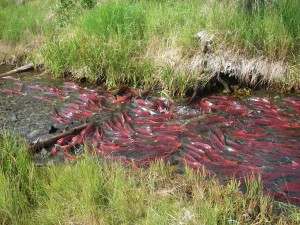
Sockeye salmon in Hansen Creek, Alaska
My students, post-docs, and I have been studying the behavior, ecology, evolution, and conservation of salmon, trout and char. These fishes are noteworthy for their migrations and homing behavior, complex population structure, importance in commercial, recreational, and subsistence fisheries, roles are cultural icons around the Pacific Rim, and complex connections within their ecosystems. Moreover, some populations are in serious decline or have already become extinct, chiefly towards the southern end of their distribution, although others are healthy and support sustainable fisheries. Therefore, the research that we conduct integrates the natural and human-related processes affecting the fish, and we emphasize the importance of linking basic scientific investigations to conservation and management. The specific projects have varied over the years, as the interests of students, the pressing issues, and the funding opportunities have changed.
Current projects include ones conducted in western Alaska, at the University of Washington’s field camps, and ones conducted in Washington, chiefly in the Puget Sound region. As part of a long-term, multi-investigator program whose goal is to understand the basic and applied ecology of western Alaska sockeye salmon and their habitats [link to ASP website], we have studied the life history traits, spawning site characteristics, reproductive behavior, energetics, and predator-prey interactions of sockeye salmon and other fishes. Specific projects have examined: (1) the scale of population structure and homing by sockeye salmon, (2) the relationships between stream entry date, body size, population density, energetics and longevity of adult sockeye salmon in small streams, (3) the influences of habitat, body size, and sex on vulnerability of adult sockeye salmon to predation by bears, and (4) the forms of selection exerted on salmon by the commercial fishery. In addition to these projects on sockeye salmon, we are also investigating the ecology, migrations, and life history of char in the genus Salvelinus, including Dolly Varden and Arctic char, and rainbow trout.
In Washington, we have been studying the re-colonization of rivers by salmon and trout after dam modification (in the Cedar River) and removal (the Elwha River), including projects investigating estuary, river and lake habitats, in collaboration with scientists representing many different agencies and organizations. We are also investigating the migration patterns of different salmonids species in Puget Sound. This work involves a combination of ultrasonic tagging and tracking, and also analysis of coded wire tagging data, in collaboration with federal and state agency scientists. We are comparing the movement patterns of steelhead trout, cutthroat trout, bull trout, coho salmon and Chinook salmon.